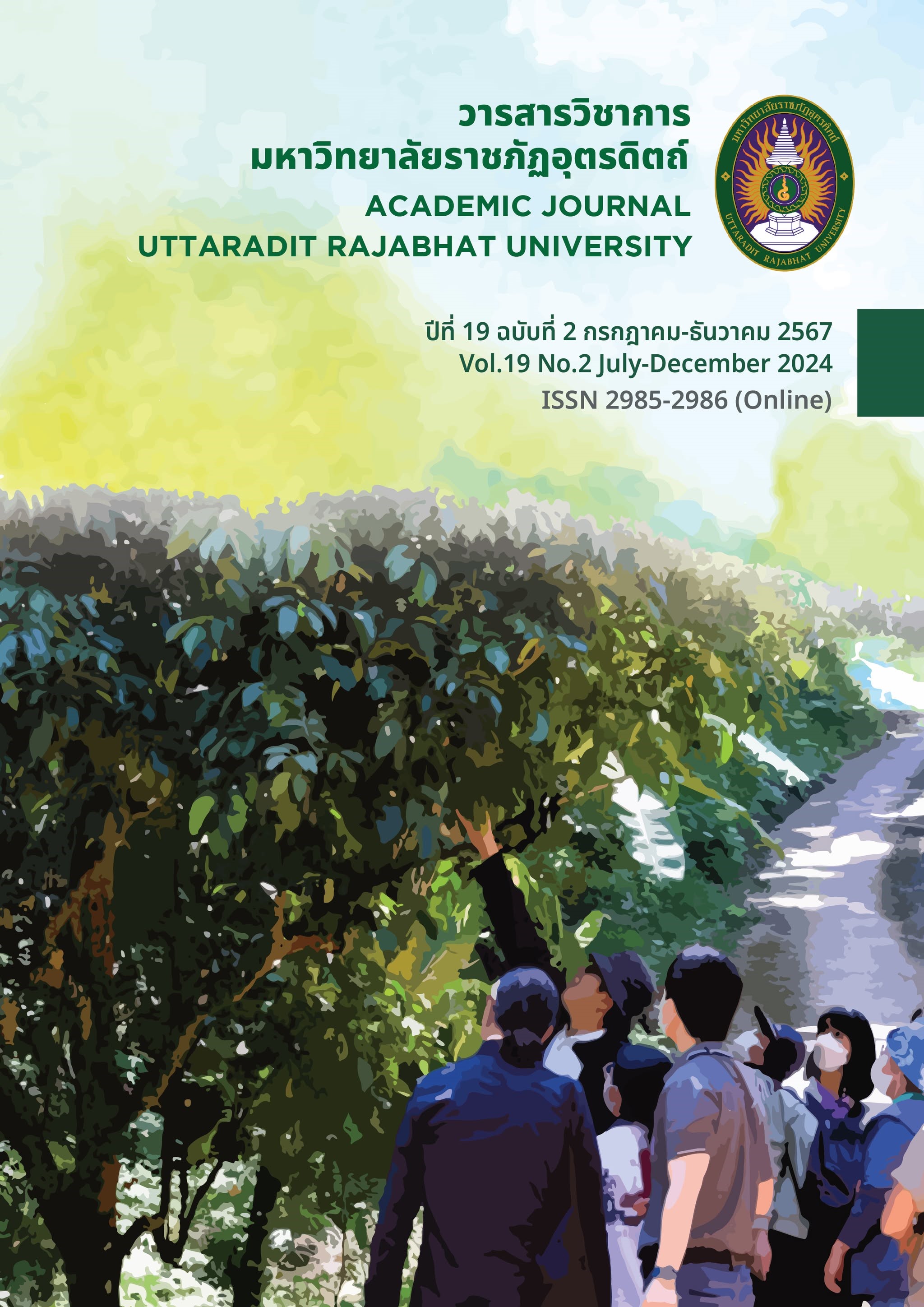STUDY THE PROCESSING OF RED SCALLOP SHELLS TO DEVELOP THE COMMUNITY SOUVENIRS
Main Article Content
Abstract
The objectives of this research were to examine the processing of crushed red scallop shells into clay suitable for molding, to investigate the molding characteristics and color of the clay made from scallop shells, and to transfer the process and prototype souvenir products made from scallop shells to the community. This experimental study was performed by using the red scallop shell powder formula ratios that had undergone a fine grinding process into seven conditions of 50%, 60%, 70%, 80%, 90%, and 100%. Each formula was produced with different combinations by varying the amounts of glutinous rice flour and corn starch, resulting in a total of 23 formulas with a 10% increase or decrease. All formulas contained preservatives, mold inhibitors, baby oil, and latex glue, which then was kneaded into a homogeneous bulk. The clay then was shaped into spiral forms. During molding, the clay was easy to shape, and did not stick to hands, retained its form when dry, and showed no cracks. The clay had a distinct shade, measured by using the CIELAB system. Then, the process and prototype keychains souvenir, were transferred to 10 representatives of the Ban Nam Chieo Tourism Community Enterprise. The suitable clay formula was found to be 80% red scallop shell powder, 10% corn starch, and 10% glutinous rice flour. The clay appeared in a pink tone as the CIELAB color results were L* = 79.04 ± 1.92, a* = 9.65 ± 0.07, and b* = 3.69 ± 0.15. The molding results showed that every clay formula could be molded into lines and spiral shapes. The samples exhibited no cracks and retained their original shape once fully dry. Each shape varied in its difficulty and ease in molding. Corn starch made the molding clay soft and gave it a smooth surface, while glutinous rice flour made the clay more flexible. When higher glutinous rice flour were added, the clay became prone to collapsing during molding. If the clay contained a large amount of red scallop shell powder, its toughness decreased, causing it to break easily when molded into lines. The creation of prototype keychain clay made from scallop shells in various shapes was transferred as souvenirs to be sold for the community enterprise. This knowledge could be further developed into a supplementary occupation to add value, increase income, and create new activities to promote tourism in the Nam Chieo Subdistrict community.
Downloads
Article Details

This work is licensed under a Creative Commons Attribution-NonCommercial-NoDerivatives 4.0 International License.
References
กิตติกรณ์ บำรุงบุญ และปิยลักษณ์ โพธิวรรณ. (2564), การพัฒนาผลิตภัณฑ์ของที่ระลึกที่สะท้อนอัตลักษณ์ท้องถิ่นจังหวัดมหาสารคาม เพื่อยกระดับมูลค่าทางเศรษฐกิจ, วารสารมนุษยศาสตร์และสังคมศาสตร์ มหาวิทยาลัยมหาสารคาม, 40(2), 7-24.
ชลิต เฉียบพิมาย, เฉลิมเกียรติ เฟื่องแก้ว, และสุเมษย์ หนกหลัง. (2564). กระบวนการจัดการท่องเที่ยวโดยชุมชนของชุมชนบ้านน้ำเชี่ยว จังหวัดตราด. วารสารวิชาการวิทยาลัยบริหารศาสตร์, 4(2), 151-165.
ภัทรา ศรีสุโข , กิตติรัตน์ รุ่งรัตนาอุบล, นฤมล เลิศคำฟู, ภัทรบดี พิมพ์กิ, และสุรพงษ์ ปัญญาทา. (2565). ศึกษาและทดลองการแปรรูปเปลือกหอยแมลงภู่บดเหลือทิ้งเพื่อการผลิตดินปั้นสำหรับงานเครื่องประดับเพื่อชุมชน (รายงานการวิจัย). มหาวิทยาลัยราชภัฏรำไพพรรณี.
ภัทรา ศรีสุโข, กิตติรัตน์ รุ่งรัตนาอุบล, นฤมล เลิศคำฟู, ภัทรบดี พิมพ์กิ, และสุรพงษ์ ปัญญาทา. (2566). การพัฒนาดินปั้นงานเครื่องประดับจากเปลือกหอยแมลงภู่บดเหลือทิ้ง สำหรับวิสาหกิจชุมชนท่องเที่ยวบ้านน้ำเชี่ยว จังหวัดตราด, วารสารวิชาการ มหาวิทยาลัยราชภัฏอุตรดิตถ์, 18(2), 75-84.
เมธินี ทะนงกิจ, ฐาศุกร์ จันประเสริฐ, และศยามล เอกะกุลานันต์. (2561). ปัจจัยแห่งความสำเร็จของการท่องเที่ยวเชิงสร้างสรรค์กรณีศึกษาวิสาหกิจชุมชนท่องเที่ยวบ้านน้ำเชี่ยว. วารสารวิชาการการท่องเที่ยวไทยนานาชาติ, 14(1), 77–109.
วันทนา อยู่สุข และธีระพงศ์ ด้วงดี. (2552). หอยในทะเลไทย. ใน สารานุกรมไทยสำหรับเยาวชนฯ (เล่ม 34, หน้า 173-174). มูลนิธิโครงการสารานุกรมไทยสำหรับเยาวชน. https://www.saranukromthai.or.th/sub/ book/book.php?book=34&chap=5&page=t34-5-infodetail05.html
สาทินี วัฒนกิจ และวรสุดา ขวัญสุวรรณ. (2564). การสร้างมูลค่าเพิ่มให้กับวัสดุเหลือทิ้งสู่ผลิตภัณฑ์ออกแบบตกแต่ง: ชุมชนต้นแบบเทศบาลเมืองเขารูปช้าง. วาสารสถาปัตยกรรม การออกแบบและการก่อสร้าง, 3(2), 13–27.
สำนักงานพัฒนาชุมชนจังหวัดตราด. (2565, 1 มีนาคม). พช. ตราด ร่วมต้อนรับอธิบดีกรมความร่วมมือระหว่างประเทศ. https://trat.cdd.go.th/2022/03/01
โสภิดา วิศาลศักดิ์กุล, อรวัลภ์ อุปถัมภานนท์, และสริดา จารุศรีกมล. (2562, 26 เมษายน). การพัฒนาผลิตภัณฑ์ดินปั้นจากกากมะตูม [การนำเสนอบทความ]. งานประชุมวิชาการระดับชาติ มหาวิทยาลัยรังสิต. https://rsucon.rsu.ac.th/files/proceedings/nation2019/NA19-073.pdf
Cabacaba, Nonita S., Boiser, Ed-Marie B., Badocdoc, Kimberly A., & Campo, Cristan Joy M. (2020). Breeding and larval rearing of Asian moon scallop Amusium pleuronectes in eastern samar, Phillippined. The Philippine Journal of Fisheries, 27(1), 104-120. https://doi.org/10.31398/tpjf/27.1.2019A0008
Zhang, C., & Zhang, R. (2006). Matrix proteins in the outer shells of molluscs. Marine Biotechnology, 8, 572-586. https://doi.org/10.1007/s10126-005-6029-6


